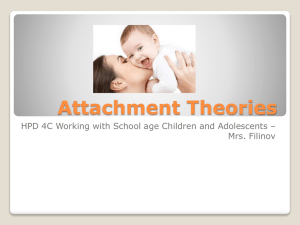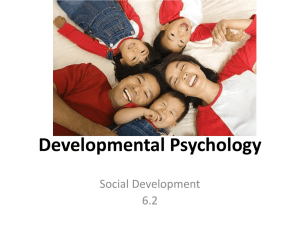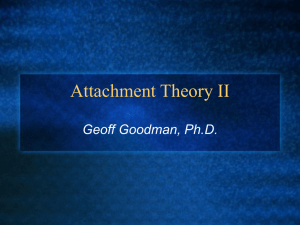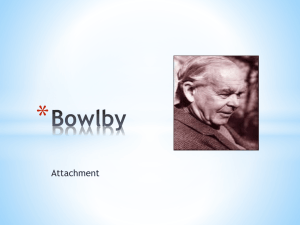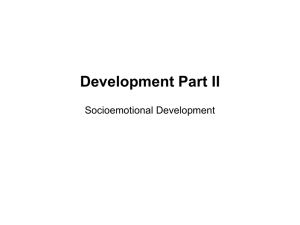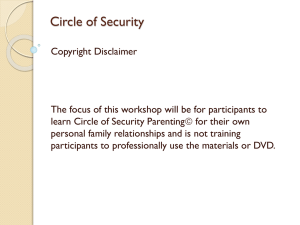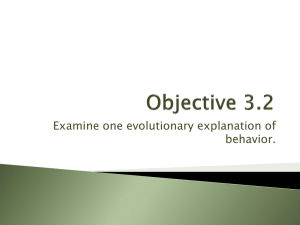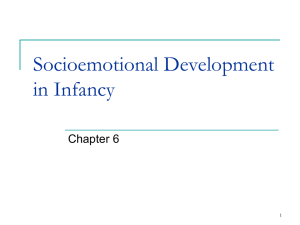Social development
advertisement
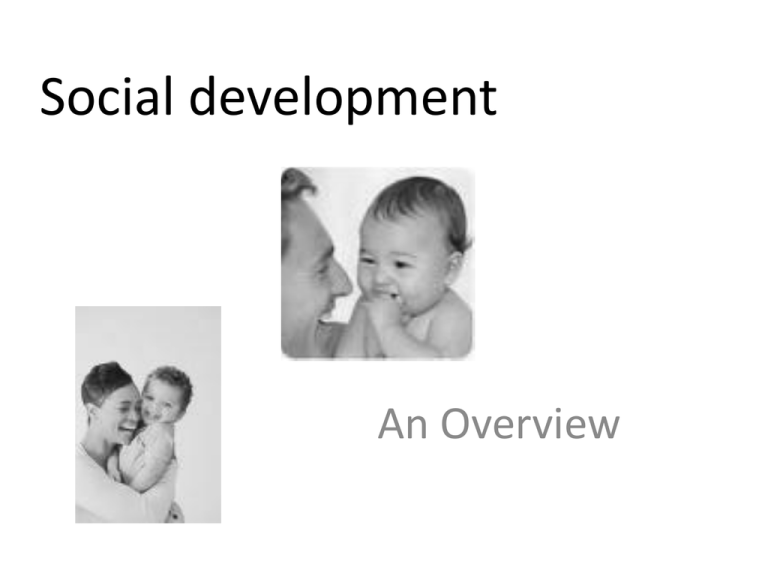
Social development An Overview What is Social development We are social beings We are exposed to a social world from the day we are born This social world shapes the way we grow. Social Development: A definition Social development refers to the development of interaction with the human world around us, including relationships with others and also the social skills we need to fit into our culture or society. How do we study Social development! Observations Animal participants (Harlow 1959) Interviews Naturalistic studies Human participants. Qualitative data Early Relationships • Schaffer (1996) • ‘Defined attachment as a long enduring emotional meaningful tie to a particular individual’ • The bond is characterised by a desire for closeness to individuals such as the primary caregiver • This attachment source will often offer comfort, security and other primary needs. Attachment: A definition “A close and consistent emotional bond with mother” (Bowlby 1940s) “An affectional tie that one person or animal forms between himself and another specific one – a tie that binds them together in space and endures over time” (Ainsworth & Bell, 1970) Schaffer & Emerson (1964) • 60 Glasgow infants • Carried out observations and interviews with parents at regular intervals during the first 18 months after birth • They found that a particular pattern of attachment occurred in a significant amount of participants. Stages of Attachment (Schaffer & Emerson 1964) Stage/ Age Type of Attachment Asocial (0-6 weeks) Babies respond in a similar way to people and objects, although they prefer to look at human-like stimuli. Diffuse (6 weeks to 6 months) Babies show no particular preference for a specific individual and will be comforted by anyone. Single strong attachment Babies show a strong preference for a single individual and (7 to 12 months) will show fear of strangers. Multiple attachments (12 months onwards) Babies will show attachment towards several figures. By 18 months some infants have as many as five attachment figures. The Functions of Attachment Initially it was thought infants attach to the person who provide food Rhesus monkeys prefer to spend time with cloth mother instead of the wire monkey that feeds them. However babies do not always attach to the person who feeds them but to those who comfort (Harlow 1959) The Functions of Attachment cont. Evolutionary psychologists have suggests that attachment is crucial for survival Attachment is useful to avoid predators attachment gives protection from a group and is vital for survival Bowlby (1969) proposed attachment provides and internal working model of relationships Attachment therefore provides a mental view of what relationships are and gives expectations in later life. Observable attachment behaviours Greeting Watching Crying Using as a safe base i.e. Playing close to caregiver Following Stranger fear. Ainsworth (1978) The Strange Situtaion • This study has been replicated many times and is now a standard measure for measuring type and quality of attachment • The Aim was to study the reactions of children to Brief separations from the mother • A controlled observation infants were exposed to a sequence of 3 minute episodes starting the with mother and child and then strangers were introduced • The behaviours were recorded. The Strange situation Cont. • Ainsworth classified infants as: – Securely attached – Anxious avoidant – Anxious resistant • • • • 65% fell into the secure catagory 15-20% were in the other 2 catagories What conclusions can be made? What ethical issues are there? Key questions to think about Is the strange situation a good indicator of the child’s overall behaviour? Is attachment behaviour consistent through time? What if the child is disabled? Van Ijzendoorn The strange situation • Replicated the strange situation study that Ainsworth did in 1978 • However he looked cross culturally • He found cross cultural differences in attachments • Japanese infants show high amount of resistant attachment • German infants show more avoidant attachments (Grossmann et al. 1985) John Bowlby’s Ethological Theory • “Ethological Theory of attachment recognises the infant’s emotional tie to the caregiver as an evolved response that promotes survival” – The Instinctive nature of attachment – The importance of parental responsiveness to innate behaviours – A critical or sensitive period early in a child’s life when attachments must development. Bowlby’s 44 juvenile thieves study • His theory supported by his 1944 study of ‘delinquent boys’ • 44 boys who have suffered from maternal deprivation in early childhood • Bowlby (1951) labelled boys “Affectionless psychopathy” • Bowlby concluded that delinquency is related to maternal deprivation Criticisms of Bowlby • Early research did not account for other factors • Is there a critical period? • Death of parent does not lead to affectionless psychopathy • Depravation effects in monkey’s have been shown to be reversible. Are there any other problems with Bowlby’s study?
